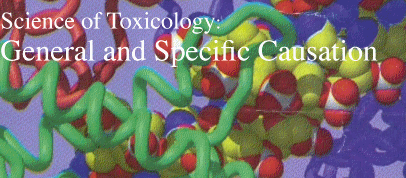

Risk Assessment is another type of causation: predicting whether an exposure, usually in a population rather than a single individual, will increase the risk of developing some adverse health effect, without necessarily determining whether such health effect actually occurs. Risk means that all such exposed individuals are more likely to develop an adverse effect, but it does not mean that any particular individual will or even that the majority of individuals will. Smoking, for example, increases risk of lung cancer from approximately one in 100 to 1 in 10--a signficiant increase. Nevertheless, ninety percent of smokers do not develop lung cancer, even though they are all at increased risk. Risk Assessment is used by regulatory agencies, such as the EPA, to determine how much of a chemical can be released into the environment without causing an unacceptable increase in risk of an adverse effect. 'Unacceptable' is more of a policty decision than a scientific one.
Specific causation analysis can be divided into the following three components:
(1) Hazard Assessment
(2) Exposure Assessment
(3) Health Assessment
(1) Hazard Assessment: what harm can the chemical cause, based on intrinsic toxicity and circumstnaces of exposure, form of chemical (gas, liquid, solid) and susceptibility of individual.
(2) Exposure Assessment how much of the chemical is in a media (air, water, food, soil) available to be taken into the body? Is this a one-time or multiple exposure? Does it occur over a short period of time (acute) or over many months or years (chronic)? How does the length of exposure affect the toxicity of the chemical? How much of the chemical gets absorbed into the body (dose), and where in the body does it end up (distribution and target organ/tissue)?
(3) Health Assessment: what type of health effect develops (or gets exacerbated), and does this occur immediately or after a delay (lag time)? Is this a new effect in the individual or is there a history of this type of problem, made worse by the chemical exposure? Is the individual in a high risk group (in utero, infant, elderly, reduced immune function)? Are there other (alternative) known causes for this problem and were these causes present ?
Specific and General Causation
General causation concerns the question of whether a chemical can cause an adverse effect. The ability to cause such an effect is referred to as its toxicity. Hazard is the likelihood of such effect occurring. Some highly toxic chemicals present little hazard because of careful handling; whereas some chemicals with little toxicity present a significant hazard because of poor handling, perhaps due to lack of concern.
Specific causation asks the question of whether a chemical did cause an adverse effect, under a specific set of exposure and personal circumstances. Specific causation is based upon prior proof of general causation; it is not possible to establish, within the same event general and specific causation, unless the effect is quite rare and dose response relationships are established for the exposure. Specific caustion requires a number of steps, including determination that general causation exists. Other steps involve exposure and health assessment, consideration of alternative causes, and finally, whether all the pieces of the puzzle fit together or not. The last step is to some degree a judgement call.
It is important in evaluating the literature or simply the interpretation of data, to be sure whether the question involves an issue of general causation or specific, so as to determine whether what is concluded from the data makes sense.